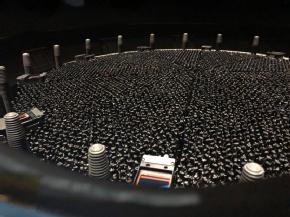Telescope instrument opens its 5,000 eyes for the first time
 A leading-edge new telescope instrument, designed and built by an international collaboration that involves University of Warwick scientists, has today (28 October) aimed its 5,000 fibre-optic eyes at the night sky for the first time.
A leading-edge new telescope instrument, designed and built by an international collaboration that involves University of Warwick scientists, has today (28 October) aimed its 5,000 fibre-optic eyes at the night sky for the first time.
The Dark Energy Spectroscopic Instrument (DESI) will provide very precise measurements of the Universe’s expansion rate. It is thought that gravity slowed this rate of expansion in the early Universe – but it has recently been demonstrated that the expansion of the Universe is speeding up, although scientists are yet to discover why. Dark energy is one ingredient thought to be contributing to this, and DESI will seek to measure its effect.
The installation of the instrument on the four-metre Mayall Telescope at the Kitt Peak National Observatory in Arizona, in the United States, is nearly complete and final testing has begun, with DESI capturing its first images of galaxies up to 11 billion light years away. When formal observations begin in 2020, DESI will look back in time at the early universe to create the most detailed 3D map of the universe ever created.
The DESI collaboration has participation from nearly 500 researchers at 75 institutions in 13 countries, including the UK. STFC, as part of UK Research and Innovation, provided £2.4million funding to facilitate DESI instrumentation development at Durham University and at UCL, and to enable about 30 UK academic staff and students to participate in DESI.
The UK institutions in the DESI UK Collaboration are Durham, Portsmouth, UCL, Edinburgh, St Andrews, Cambridge and Warwick.
Professor Ofer Lahav from UCL, the chair of the DESI UK consortium of seven universities, said: “The ability of DESI to capture the spectra of 5,000 different galaxies simultaneously is about 10 times more than previously achieved. By looking back in time by up to about 11 billion years, DESI will expose secrets of the universe’s infancy and early development.
“This new information will help us better understand the physical processes driving the accelerating expansion of the universe, one of the key unsolved questions in physics. It will also teach us about the nature of dark matter, including finding the mass of the illusive neutrinos.”
The optical corrector, led by UCL, allows the 5,000 ‘eyes’ of fibre-optic cable to be arranged over 8 square degrees. The design includes four large lenses of fused silica and two smaller lenses, which expand the telescope’s viewing window by about 16 times.
Professor Peter Doel, who was in charge in assembling the DESI optical corrector said: “It’s been incredibly satisfying seeing the first images from DESI using the specialist equipment made in the UCL Optical Science Laboratory and we are looking forward to the survey officially starting early next year”.
The fibre-optic system, led by Dr Luke Tyas’ team at Durham University, carries the light to the spectrograph, where it splits that light into narrow bands of colour to precisely map their distance from Earth and gauge how much the universe expanded as this light traveled to Earth. In ideal conditions DESI can cycle through a new set of 5,000 galaxies every 20 minutes.
DESI team member Professor Carlos Frenk from Durham University said: "The DESI project epitomizes the best of modern science. It is designed to answer a fascinating question about the fundamental fabric of our universe: what is causing the cosmic expansion to speed up? It will collect 10 times more data on galaxies, quasars and stars in the Milky Way than humans have collected to date, stretching back to the early phases of our universe. Bringing together scientists from 13 countries, DESI shows how people from across the globe can come together to tackle key scientific questions."
By repeatedly mapping the distance to 35 million galaxies and 2.4 million quasars across one-third of the area of the sky over its five-year run, DESI will teach us more about dark energy. Quasars, among the brightest objects in the universe, allow DESI to look deeply into the Universe’s past.
University of Warwick astronomers lead an ambitious program within the UK's DESI collaboration that will eventually obtain observations of tens of millions of stars, which will be used to unravel both the formation of the Milky Way, as well as the formation, evolution, and demise of stellar and planetary systems.
DESI is led by the Lawrence Berkeley National Laboratory (LBNL) in the US, supported by funding from the Department of Energy.
“After a decade in planning and R&D, installation and assembly, we are delighted that DESI can soon begin its quest to unravel the mystery of dark energy,” said DESI Director Michael Levi of LBNL.
"Most of the universe’s matter and energy are dark and unknown, and next-generation experiments like DESI are our best bet for unraveling these mysteries,” Levi added. “I am thrilled to see this new experiment come to life."
Read the full release, including details of the international partners, on the LBNL website.
Ends
28 October 2019
For further information contact:
Peter Thorley
Media Relations Manager (Warwick Medical School and Department of Physics)
Email: peter.thorley@warwick.ac.uk
Tel: +44 (0)24 761 50868
Mob: +44 (0) 7824 540863
